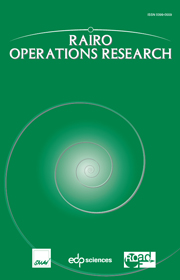No CrossRef data available.
Article contents
Des explications pour reconnaîtreet exploiter les structures cachéesd'un problème combinatoire
Published online by Cambridge University Press: 14 February 2007
Abstract
L'identification de structures propres à un problème est souvent une étapeclef pour la conception d'heuristiques de recherche comme pour la compréhension de lacomplexité du problème. De nombreuses approches en Recherche Opérationnelleemploient des stratégies de relaxation ou de décomposition dès lors quecertaines struc-tures idoines ont été identifiées. L'étape suivante est laconception d'algorithmes de résolution qui puissent intégrer à la volée,pendant la résolution, ce type d'information. Cet article propose d'utiliser unsolveur de contraintes à base d'explications pour collecter une informationpertinente sur les structures dynamiques et statiques inhérentes au problème.
- Type
- Research Article
- Information
- RAIRO - Operations Research , Volume 40 , Issue 4: Journées Francophones de Programmation par Contraintes 2005 , October 2006 , pp. 381 - 401
- Copyright
- © EDP Sciences, 2007


